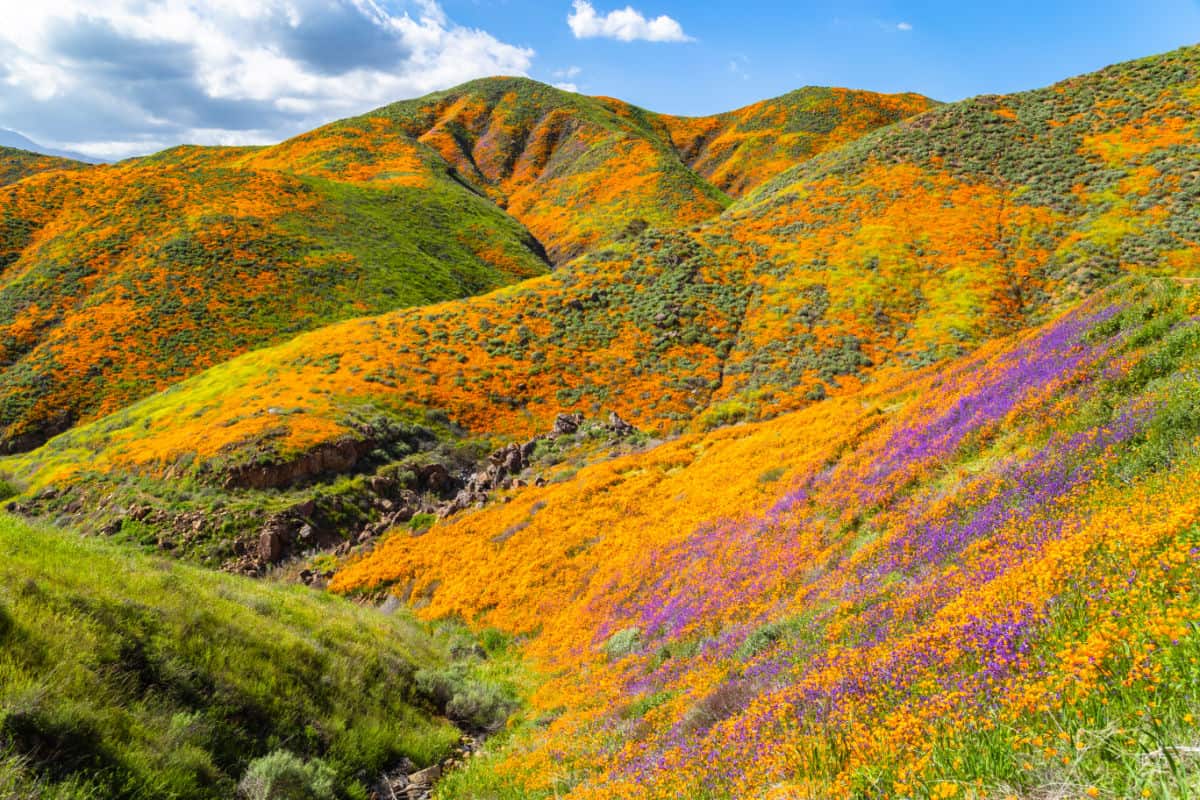Spring is upon us, and forecasters are predicting a rare superbloom throughout the U.S. Southwest and California. Although California saw its last superbloom in 2019, this phenomenon typically only happens every 10 to 15 years due to the very specific conditions required.
Superblooms occur throughout grassland and desert regions, which generally don’t get much rainfall. More rainfall than usual in the fall and winter seasons, paired with mild temperatures and lack of wind, can cause dormant seeds to hydrate and sprout, resulting in a massive bloom of wildflowers come spring.
Wildflowers will start to bloom as early as February and can even be seen into June and July, but peak season is March to April. You can find them in arid regions of California, Arizona, and Nevada, and of course, state and national parks are some of the best wildflower-spotting locations.
So here are 5 national parks you can visit this spring to see the superbloom:

1. Death Valley National Park
Death Valley National Park is a spectacular and unique desert landscape on the border of California and Nevada. It is one of the more famous places to seek out a superbloom, likely because it’s such a rare occurrence.
Being the hottest place on earth, this environment isn’t usually conducive to producing blankets of wildflowers. That makes it an incredible sight to see when conditions are perfect enough for a superbloom to take place here. In the spring, whether there’s a superbloom or not, visitors can see wildflowers such as desert gold, evening primrose, and desert lilies, as well as a variety of cacti.

2. Joshua Tree National Park
Joshua Tree is another National Park well-known for its spring blooms. Located in the Mojave and Colorado Deserts, the park is named after its unusual Joshua trees, but it’s also home to a diverse array of wildflowers.
Here you’ll find the famed California poppy, the state flower of California, as well as 250 other species of wildflowers. Blooming begins throughout the Pinto Basin in early spring and in higher elevations in late spring and even into June.

3. Channel Islands National Park
Located off the coast of Southern California, Channel Islands National Park is the only seaside park on this list, giving a drastically different landscape and environment than its desert counterparts.
This also means a different and distinct variety of wildflowers, including beach primroses and seaside daisies. Consisting of five islands, blooming typically begins earliest in the southeast.

4. Pinnacles National Park
Pinnacles National Park also has a distinct landscape, most notably its jagged rock formations and numerous caves. Its sprawling grasslands and hillsides are perfect for seeing vibrant poppies, lupines, and monkey flowers in the spring.
In this park, you can also find some rare and endangered wildflowers that you won’t see elsewhere, like the yellow mariposa lily and California jewel flower. The stunning scenery, paired with its unique wildflowers, makes Pinnacles National Park a must for a spring superbloom hike.

5. Lassen Volcanic National Park
In Lassen Volcanic National Park, you’ll find similar wildflowers to the others: the California poppy, vibrant blue lupines, and orange and yellow monkey flowers. However, you’ll also find yet another distinct and breathtaking landscape that includes volcanic formations, rolling dunes, and tranquil lakes.
Multiple trails wind through the various peaks, including the Lassen Peak Trail, which will take you to the summit of the active volcano. Because of its elevation, the best time to see the wildflowers here will be throughout the summer months, starting in May and ending towards August (and even into September for Mount Lassen).

A Few Extra Tips
Some other things to keep in mind for your own safety, as well as the sake of responsible travel, are:
- Watch out for rattlesnakes (and other wildlife).
- Leave no trace – please don’t pick any of the wildflowers or remove anything from the national parks, and of course, pick up after yourself.
- Stay on trails – for your own safety and the protection of the wildlife.
- Bring an EpiPen and/or first aid kit with you on your hikes.
- Of course, you’ll want to photograph the spectacular fields of wildflowers, but unfortunately, drones are not permitted in any national parks.

